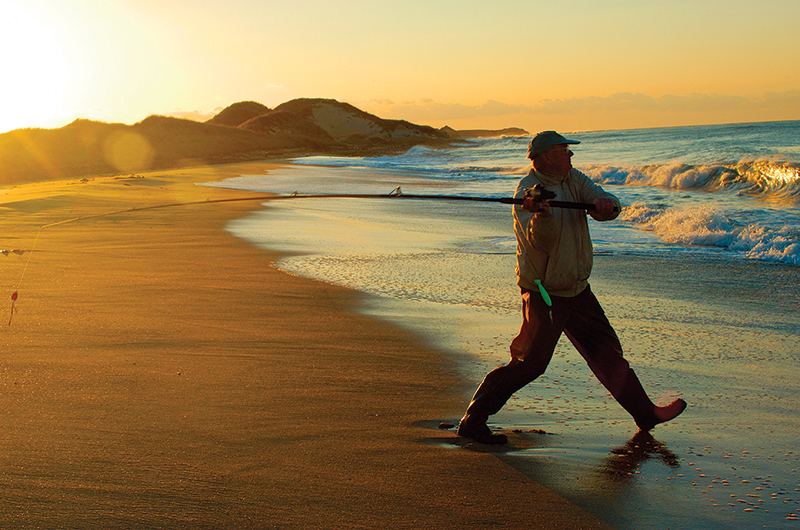In the halcyon years of Martha’s Vineyard’s rich shore fishing history – think 1963, and forty-pound-plus striped bass on tailgates – the newly introduced Jeep Wagoneer listed for $3,526, and a fisherman could drive his or her beach buggy from Gay Head to Norton Point.
That same year, Serge De Somov of Hampton Bay, New York, won the Martha’s Vineyard Striped Bass & Bluefish Derby with a fifty-two-pound, thirteen-ounce striped bass pulled from the south shore surf. It was a feat the legendary fisherman known as the Mad Russian would repeat the next two years in a row.
Almost sixty years later, coastal erosion and stiff penalties levied on those who disturb nesting shorebirds have ended the freewheeling beach vehicle access of the past. Out-of-the-way pull offs where discreet fishermen once parked have been lost to development and no trespassing signs.
So what’s a squid-dunker to do when 4,356 square feet of Chilmark Pond barrier beach real estate and a key to an association gate listed for $350,000 in June? How difficult is it to find fishing spots compared to the good old days? “Exponentially easier,” said artist Kib Bramhall of West Tisbury, who holds the Derby shore flyrod record for a forty-two-pound, fourteen-ounce striped bass he caught in 1981.
The legendary, secretive Island fisherman, now eighty-eight years old, claims a unique perspective: “As a young man, I was thrown out of virtually every fishing place you can name on Martha’s Vineyard, once at gunpoint.
” Bramhall said Island towns and conservation organizations, notably the Martha’s Vineyard Land Bank Commission and the Trustees of Reservations, provide access to many once private fishing spots. For example, he recalled fishing at Cape Pogue Gut when the “self-appointed guardian of that place” kicked him out. “Now the town of Edgartown and the land bank have parking places there,” he said.
The one change that hurts is the loss of off-road beach access. “I used to fish from Rum Runner’s Rocks to Wasque in a vehicle without ever going on a hard road,” he said. “You can’t do that anymore.
” Only Massachusetts and Maine grant private ownership to the low-water mark. Any discussion of fishing access rights inevitably leads to the colonial ordinances. Enacted between 1641 and 1647 by the Great and General Court, the term now applied to the state legislature, the colonial government retained the rights for the public along the tidelands to “fishing, fowling, and navigating.
” Police take a dim view of beachgoers who try to stretch the definition of tackle to include a bottle of wine and a beach towel. The challenge for legitimate anglers is how to access the waterfront. According to the Martha’s Vineyard Commission, only 38.8 percent of the outer Island coast is public. Of the forty-seven miles of sandy barrier beach, fourteen miles are public and thirty-three are private. Then there is the inevitable locked gate.
“Back in the day,” Bramhall said, he knew how to slip the chain off a post on a gate that led to the east side of Quansoo. His tackle included a broom. “I brushed out all my tracks when I went in and when I came out again and no one ever knew,” he said with a laugh. “But we all used to become masters at deception and trespassing. It’s really a culture that’s not there anymore, and it was kind of fun too. ” Security cameras, private beach attendants, and a change in attitude have ended the fun.
Steve Morris, the owner of Dick’s Bait & Tackle in Oak Bluffs, the shop his grandfather started, said that as properties have changed hands, there is less appreciation of the Island’s fishing culture. “I remember driving out across the creek at Quansoo and driving out to the opening and nobody bothered you.” The fifty-eight-year-old fisherman and three-time Derby grand champion said he came of age just as the old ways were changing. “George Manter was still the [West Tisbury] police chief, and he’d drive out in the cruiser, and as long as there weren’t too many people out there, he was always pretty cool about it.
” In the past, fishermen were tight-lipped. Fishing information was passed along in hushed tones in the local coffee shop. The text has replaced word-of-mouth. “Really?” Morris said. “I mean, I wouldn’t tell my grandfather where I caught the fish or tell my father.”
Fishing etiquette and obscure Island dirt roads once protected fishing spots. Google Maps has removed the mystery. “Stevie Amaral took me places, and I would never go there and fish without him,” Morris said. “You just didn’t do that. Now, you take somebody to a spot fishing, and before you know it, they’re down there with three buddies.”
One aspect of fishing that has not changed is unexpected encounters. You just never know who you might meet on the beach. Bramhall said that when he was a teenager, “way back when,” he snuck into Squibnocket, a fabled and private Chilmark fishing spot. “I was fishing on the bass stand at dusk, and an elderly man came out, and he was fishing too, and he said, ‘Why are you here?’ And I said, ‘Well, I’ve got permission from Mr. Hornblower.’ And he said, ‘Well, I am Mr. Hornblower, and you’re welcome to stay here and fish with me, but please don’t ever come back.’”





